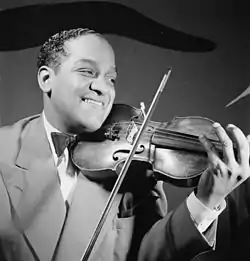Conk
The conk (derived from congolene, a hair straightener gel made from lye) was a hairstyle popular among African-American men from the 1920s to the 1960s.[1] This hairstyle called for a man with naturally "kinky" hair to have it chemically straightened using a relaxer (sometimes the pure corrosive chemical lye), so that the newly straightened hair could be styled in specific ways. Often, the relaxer was made at home, by mixing lye, eggs, and potatoes, the applier having to wear gloves and the receiver's head having to be rinsed thoroughly after application to avoid chemical burns.

Conks were often styled as large pompadours although other men chose to simply slick their straightened hair back, allowing it to lie flat on their heads. Regardless of the styling, conks required a considerable amount of effort to maintain: a man often had to wear a do-rag of some sort at home, to absorb sweat or other agents to keep them from causing his hair to revert to its natural state prematurely. Also, the style required repeated application of relaxers; as new hair grew in, it too had to be chemically straightened.[2][3]
Many of the popular musicians of the early to mid 20th century, including Chuck Berry, Fats Domino, Louis Jordan, Little Richard, James Brown, and the members of The Temptations and The Miracles, were well known for sporting the conk hairstyle. The gatefold of the 1968 album Electric Mud shows blues legend Muddy Waters having his hair conked. The style fell out of popularity when the Black Power movement of the 1960s took hold, and the Afro became a popular symbol of African pride. The conk was a major plot device in Spike Lee's film biography Malcolm X, based upon Malcolm X's own condemnation of the hairstyle as black self-degradation in his autobiography because of its implications about the superiority of a more "white" appearance and because of the pain the process causes and the possibility of receiving severe burns to the scalp.[4]
The conk is all but extinct as a hairstyle among African-American men today, although more mildly relaxed hairstyles such as the Jheri curl and the S-curl were popular during the 1980s and 1990s.
Culture
In The Autobiography of Malcolm X, it is mentioned that at one point the prevalence of the conk hairstyle, "makes you wonder if the Negro has completely lost all sense of identity, lost touch with himself".[5]
Documentary
The history of the conk is featured in Bayer Mack's 2019 documentary, No Lye: An American Beauty Story, that chronicles the rise and decline of the black-owned ethnic beauty industry.[6]
References
- "Conk, Afro, Jherri Curl, Dreadlocks & Afro". Jazma Hair. Retrieved 8 November 2016.
- Craig, Maxine (November 1997). "The Decline and Fall of the Conk; or, How to Read a Process". Fashion Theory. 1 (4): 399–419. doi:10.2752/136270497779613657. ISSN 1362-704X.
- Tyler, Bruce (1990). "Black Hairstyles, Appearance, Conduct and Cultural Democracy". The Western Journal of Black Studies. 14 (4): 235.
- X, Malcolm; Haley, Alex (1965). The Autobiography of Malcolm X. New York: Grove Press.
- X, Malcolm (2015). The Autobiography of Malcolm X (reprint ed.). Random House Publishing Group. p. 65. ISBN 9781101967805. Retrieved 2 May 2017.
- "EXTRA! EXTRA! READ ALL ABOUT IT! 'NO LYE: AN AMERICAN BEAUTY STORY' GIVES EXCELLENT HISTORY LESSON". EURweb.com. 2019-12-03. Retrieved 2019-12-13.
External links
 Media related to Conk (hairstyle) at Wikimedia Commons
Media related to Conk (hairstyle) at Wikimedia Commons The dictionary definition of conk at Wiktionary
The dictionary definition of conk at Wiktionary